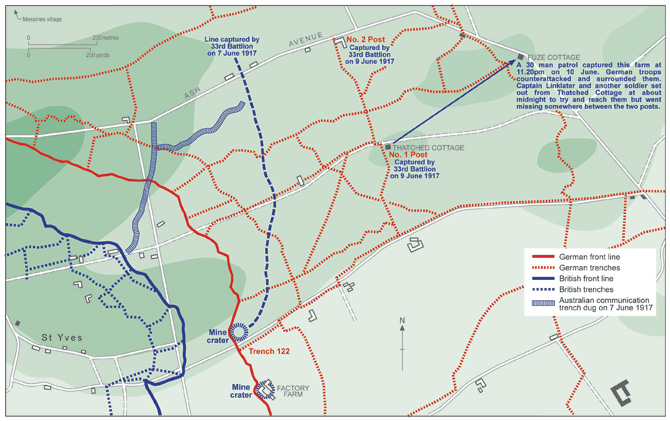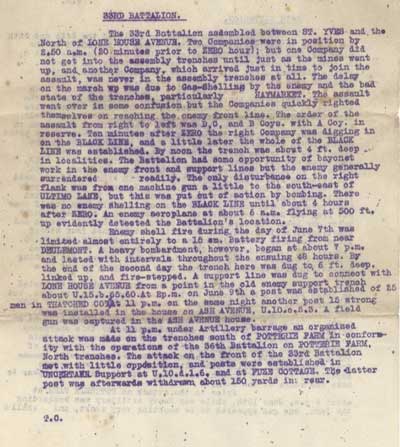Document 16 - Zero Hour
Report on 33rd Battalion during the Battle of Messines
Linklater's battalion was on the extreme right flank of the entire British offensive at Messines Ridge. On the night before the battle, Linklater led his company up to the front lines through Ploegsteert Wood.
This map illustrates the 33rd Battalion's work during the Battle of Messines. There are two accounts of the battle. One is a private records from the diaries of an Australian soldier in Linklater's battalion named Dick Bloomfield. The other is the 33rd Battalion's official report written by the unit's commanding officer after the battle.


Russian sap across no man's land
View across no man's land from the 33rd Battalion's starting positions on 7 June 1917. The battalion dug the sap in the centre (known as a 'Russian sap') so they could transport supplies up to the newly captured trenches ahead.

Mine crater, Factory Farm
The British tunneled under the German front line here and planted 1.8 tonnes of explosive. It was blown up just before the Australians attacked at dawn on 7 June 1917.

View across no man's land
This is the perspective from the Australian front line trenches across no man's land to the enemy's front line, which ran between the trees. The Germans had at least one concrete pillbox in the trees on the right.

Side on view of no man's land
The 33rd Battalion's front line ran along the road on the right. The German front line was in the trees on the left. The 33rd Battalion advanced across this field at dawn on 7 June 1917

British soldiers in the front line at St Yves
The trenches around St Yves required extensive timber and corrugated iron riveting to keep the walls from caving in. This was due to the soil's high water content. Prior to the Battle of Messines in June 1917, this was one of the Western Front's quieter sectors.

View across no man's land from the German front line
German machine gunners had a perfect field of fire across the ground crossed by the 33rd Battalion during the Battle of Messines. The Australian front line followed the line of telegraph poles. Ploegsteert wood, where the Australians were gassed on their way to the battlefield the night before the attack is in the background, to the left.

Messines Ridge and village, viewed from the German trenches
The Australians attacked the ground in between Factory Farm and the foot of Messines Ridge. The New Zealanders, advancing next to them captured the ridge and village. When Dick Bloomfield, a solider in the 33rd Battalion advanced he looked in this direction and described, "Dawn was just breaking, but in the flash of the guns we could see lines of men running for miles away towards Messines on the ridge."

Trench 122 mine crater
The British exploded a mine here at zero hour on 7 June 1917 to assist the Australian attack. Soldiers from the 33rd Battalion captured the crater and fortified it with wire and Lewis guns to beat off German counter attacks.

German machine gun positions in the Ultimo Switch
Australian Lewis gunners set up in this position on the edge of the mine crater. German machine gunners from outside of the battle area poured fire onto them throughout the morning. A German machine gun crew in the nearer farmhouse was particularly troublesome until the Australians brought up a trench mortar to destroy it.

Track leading towards Thatched Cottage
On 9 June, a patrol from the 33rd Battalion crept along this track to capture the German strongpoint known as 'Thatched Cottage'. They renamed it 'No. 1 Post'.

German trench following the battle
The British creeping barrage that attacking troops followed absolutely shattered the German trenches. Some Australian soldiers reported they couldn't even recognise where the German trenches had been.

View from Thatched Cottage (No. 1 Post) towards Fuze Cottage (No. 2 Post)
The tactical usefulness of No. 1 Post is clear in this photograph. It occupied a slight rise in the ground that dominated the enemy held country to the east. During the night of 10 June, Linklater's company attempted to capture another post at Fuze Cottage, approximately where the farm with the orange roof is today. Linklater went missing somewhere in this area.

Destroyed German pillbox
Around Messines, the Germans used concrete pillboxes in their trench systems. These structures could withstand even direct his from artillery shells. This pillbox, close to the Factory Farm mine, was turned completely over, illustrating the power of the explosion and the usefulness of the mines to the Australian infantry who would have otherwise needed to attack these structures head on.
Dick Bloomfield, a soldier in Linklater's company recorded his recollections of Battle of Messines in his diary.
6 June 1917
Zero hour was planned for 3.10am on June 7th 1917, the battalion to start up at dusk on the previous evening. No one seemed to be troubled, but I noticed an enormous pile of uncensored letters from C Company. I took the risk and signed the lot. There wasn't enough time to read and censor them.
It was quiet enough moving up until Fritz started drenching the woods with gas shells. There was no mistaking the 'plomp' as they landed. Gas masks added to the pitchy darkness and one could not see, only feel one's way along the sides of the trench.
A carrying party in front got panicky and would not move. I heard my runner, Newman, gasp and fall in the darkness behind me. He was left over the parapet to avoid being trampled to pieces.
Captain Linklater struggled up on top and roared the carrying party out of the way. A large man, he missed his footing and fell heavily into the trench. In the gas he had to take the rise and remove the mouthpiece of his mask, replacing it after each sentence...
At 3.05 we arrived at the assembly trench. 'B' Company had arrived on the left but 'D' on the right had still not arrived. It was now very still, with the occasional shell soaring overhead. We could hear them burst in the back areas. The men were surreptitiously and quietly smoking, leaning against the trenches. Bayonets were ready fixed. At five minutes to go I reported to Captain Linklater that 'D' Company had not arrived. 'We will do their lot too', he said.
Just for a moment most of us thought Fritz had got in first. The mines went up and the guns opened their barrage in one terrific concussion and uproar. Dawn was just breaking, but in the flash of the guns we could see lines of men running for miles away towards Messines on the ridge. On the right, 'D' Company were struggling over the bags. 'C' Company had to sway back to keep touch. Only one machine gun seemed to be rattling out in front, but men fell.
We took the first two lines of trenches. I did not see one German, but they were roaring out down in their dugouts and we dropped bombs in while passing. Just as we reached our objective, four Germans darted away out of a shellhole in front of Lieutenant Duncan, who dropped to one knee and shot all four. His batman bayoneted each in turn. 'Just in case they're foxing,' he explained. Two German ambulance men were in a dugout just beyond our lines, where they had a dressing station. They were the only prisoners I saw, though there must have been large numbers captured in the dugouts behind us. I got some good souvenirs out of the dressing station. Byrnes, Duncan's runners, got a beautiful revolver out of an overcoat on the wall. Sergeant Flick showed me eight watches he had collected. All the bayonets and equipment were new. Black bread was almost the only food found, and it tasted like sawdust.
On the right 'D' Company was being heavily shelled. I could see Major White, standing on top, directing the digging in. On the left, Sergeants Mountain and Nelson were digging lustily with their men. In an incredibly short time all were out of sight...
In a remarkably short time, 'B', 'C' and 'D' Companies had formed their new front line [dashed blue line on the map]. 'A' Company was digging a communication trench across no-man's-land and a carrying party brought up water supplies in petrol tins, with petrol still in most of them...
Away on the ridge we could see the New Zealanders leap frogging over. They took the village of Messines without difficulty.
Just at dusk the first German plane came over, flying very low and coming out of the haze from the rear. Two airmen gazed over at us. 'Now we will get some shells,' I said to Corporal Wynne. We had been picking out a line to erect barbed wire.
Sergeant Russell had a well prepared Lewis gun position away from the main German trench, but Fritz landed fair on it. Bill Reaves, No. 2 gunner, had his arm blown right off at the shoulder. 'Anyone seen my arm?' he asked, and, refusing all aid, walked out alone. Another shell burst over Corporal Wynne and myself, my share being a good 'Blighty', a term we used for a wound severe enough to warrant a spell in an English hospital.
Source: John Edwards, "Never a Step Backwards", p. 40.
The commanding officer of the 33rd Battalion wrote this report of the battle for his superiors.

Ask Yourself
- How effective was gas as an offensive weapon, even though all soldiers had respirators by 1917?
- Does any evidence in this source corroborate with other sources, regarding Linklater's qualities as an officer?
- What factors contributed to the stunning success enjoyed by the Australians at Messines?
- How significant could the actions of individuals be in high technology industrial warfare?
- The battalion secured its objectives on 7 June. How did it make them more secure in the following nights?
- Compare the official report with the two personal accounts. They describe the same event. What are the strengths and weaknesses of both as historical evidence?
